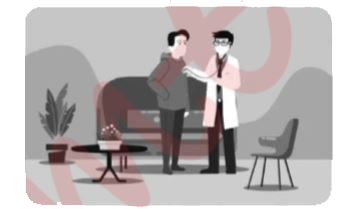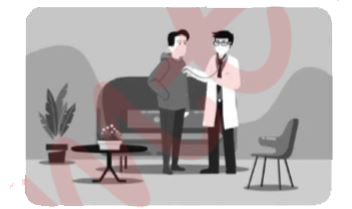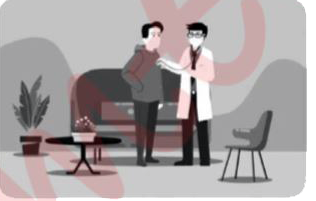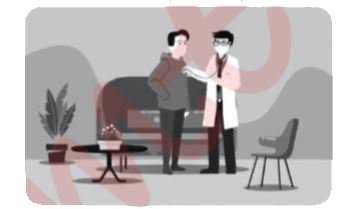A doctor is to visit a patient. From the past experience, it is known that the probabilities that he will come by train, bus, scooter or by other means of transport
are respectively 310,15,110and25.The probabilities that he will be late are
14,13and112 if he comes by train, bus and scooter respectively, but if he comes by other means of
transport, then he will not be late. When he arrives, he is late.
What is the probability
that he comes by train
To find the probability that the doctor comes by train given that he is late, we can use Bayes' theorem. Let's denote the events as follows:
- Let T1: the event that the doctor comes by train.
- Let T2: the event that the doctor comes by bus.
- Let T3: the event that the doctor comes by scooter.
- Let T4: the event that the doctor comes by other means of transport.
- Let E: the event that the doctor is late.
Step 1: Identify the probabilities
From the problem, we have the following probabilities:
- P(T1)=310 (probability of coming by train)
- P(T2)=15 (probability of coming by bus)
- P(T3)=110 (probability of coming by scooter)
- P(T4)=25 (probability of coming by other means)
The probabilities of being late given the mode of transport are:
- P(E|T1)=14 (late if he comes by train)
- P(E|T2)=13 (late if he comes by bus)
- P(E|T3)=112 (late if he comes by scooter)
- P(E|T4)=0 (not late if he comes by other means)
Step 2: Apply Bayes' Theorem
We want to find P(T1|E), which can be calculated using Bayes' theorem:
P(T1|E)=P(E|T1)⋅P(T1)P(E)
Step 3: Calculate P(E)
To find P(E), we can use the law of total probability:
P(E)=P(E|T1)⋅P(T1)+P(E|T2)⋅P(T2)+P(E|T3)⋅P(T3)+P(E|T4)⋅P(T4)
Substituting the values we have:
P(E)=(14⋅310)+(13⋅15)+(112⋅110)+(0⋅25)
Calculating each term:
1. P(E|T1)⋅P(T1)=14⋅310=340
2. P(E|T2)⋅P(T2)=13⋅15=115
3. P(E|T3)⋅P(T3)=112⋅110=1120
4. P(E|T4)⋅P(T4)=0⋅25=0
Now, we need a common denominator to sum these fractions. The least common multiple of 40, 15, and 120 is 120.
Converting each term:
- 340=9120
- 115=8120
- 1120=1120
Now summing these:
P(E)=9120+8120+1120=18120=320
Step 4: Calculate P(T1|E)
Now we can substitute back into Bayes' theorem:
P(T1|E)=P(E|T1)⋅P(T1)P(E)=(14⋅310)320=340320=340⋅203=2040=12
Final Answer
Thus, the probability that the doctor comes by train given that he is late is:
12
- Let T2: the event that the doctor comes by bus.
- Let T3: the event that the doctor comes by scooter.
- Let T4: the event that the doctor comes by other means of transport.
- Let E: the event that the doctor is late.
- P(T2)=15 (probability of coming by bus)
- P(T3)=110 (probability of coming by scooter)
- P(T4)=25 (probability of coming by other means)
- P(E|T2)=13 (late if he comes by bus)
- P(E|T3)=112 (late if he comes by scooter)
- P(E|T4)=0 (not late if he comes by other means)
2. P(E|T2)⋅P(T2)=13⋅15=115
3. P(E|T3)⋅P(T3)=112⋅110=1120
4. P(E|T4)⋅P(T4)=0⋅25=0
- 115=8120
- 1120=1120
Similar Questions
A doctor is to visit a patient. From the past experience, it is known that the probabilities that he will come by train, bus, scooter or by other means of transport are respectively 310,15,110and25.The probabilities that he will be late are 14,13and112 if he comes by train, bus and scooter respectively, but if he comes by other means of transport, then he will not be late. When he arrives, he is late.
What is the probability that he comes by trainView SolutionA doctor is to visit a patient. From the past experience, it is known that the probabilities that he will come by train, bus , scooter or by other means of transportation are respectiely 310,15,110 or 25. The probabilities that he will be late are 14,13 and 112 if he comes by train, bus and scooter respectively but if he comes by other means of transport, then he will not be late. If the arrives late, find the probability that he comes by train.
View Solution
Knowledge Check
- Question 1 - Select One
A doctor is to visit a patient. From the past experience, it is known that the probabilities that the he will come by cab, metro, bike or by other means of transport are respectively 0.3, 0.2, 0.1 and 0.4. The probabilities that the he will be late are 0.25, 0.3, 0.35 and 0.1 if he vomes by cab, metro,bike and other means of transport respectively.

Based on the above information, answer the following questions.
When the doctor arrives late, what is the probability that he comes by other means of transport ?A67B514C421D27 - Question 2 - Select One
A doctor is to visit a patient. From the past experience, it is known that the probabilities that the he will come by cab, metro, bike or by other means of transport are respectively 0.3, 0.2, 0.1 and 0.4. The probabilities that the he will be late are 0.25, 0.3, 0.35 and 0.1 if he vomes by cab, metro,bike and other means of transport respectively.

Based on the above information, answer the following questions.
When the doctor arrives late, what is the probability that he comes by bike ?A521B47C56D16 - Question 3 - Select One
A doctor is to visit a patient. From the past experience, it is known that the probabilities that the he will come by cab, metro, bike or by other means of transport are respectively 0.3, 0.2, 0.1 and 0.4. The probabilities that the he will be late are 0.25, 0.3, 0.35 and 0.1 if he vomes by cab, metro,bike and other means of transport respectively.

Based on the above information, answer the following questions.
When the doctor arrives late, what is the probability that he comes by cab ?A421B17C514D221
A doctor is to visit a patient. From past experience, it is known that the probabilities that he will come by train, bus, scooter or by car are repectively 310,15,110and25. The probabilities that he will be late are 14,13and112, if he comes by train, bus and scooter respectively, but if he comes by car, he will not be late. When he arrives, he is late. What is the probability that he has come by train ?
View SolutionA person goes to his office by using different means of transport on different days. It is know that the probabilities that he will come by train, bus, scooter or by car are respectively 110,310,210 and 410. The probabilities that he will be late are 14,15,16, and 13 if he comes by train, bus, scooter and car respectively, on one day when he reaches office, he is late. What is the probability he has come by train?
View SolutionI believe that he will come.
View SolutionA doctor is to visit a patient. From the past experience, it is known that the probabilities that the he will come by cab, metro, bike or by other means of transport are respectively 0.3, 0.2, 0.1 and 0.4. The probabilities that the he will be late are 0.25, 0.3, 0.35 and 0.1 if he vomes by cab, metro,bike and other means of transport respectively.

Based on the above information, answer the following questions.
When the doctor arrives late, what is the probability that he comes by metro ?View SolutionA doctor is to visit a patient. From the past experience, it is known that the probabilities that the he will come by cab, metro, bike or by other means of transport are respectively 0.3, 0.2, 0.1 and 0.4. The probabilities that the he will be late are 0.25, 0.3, 0.35 and 0.1 if he vomes by cab, metro,bike and other means of transport respectively.

Based on the above information, answer the following questions.
What is the probability that the doctor is late by any means ?View Solution

